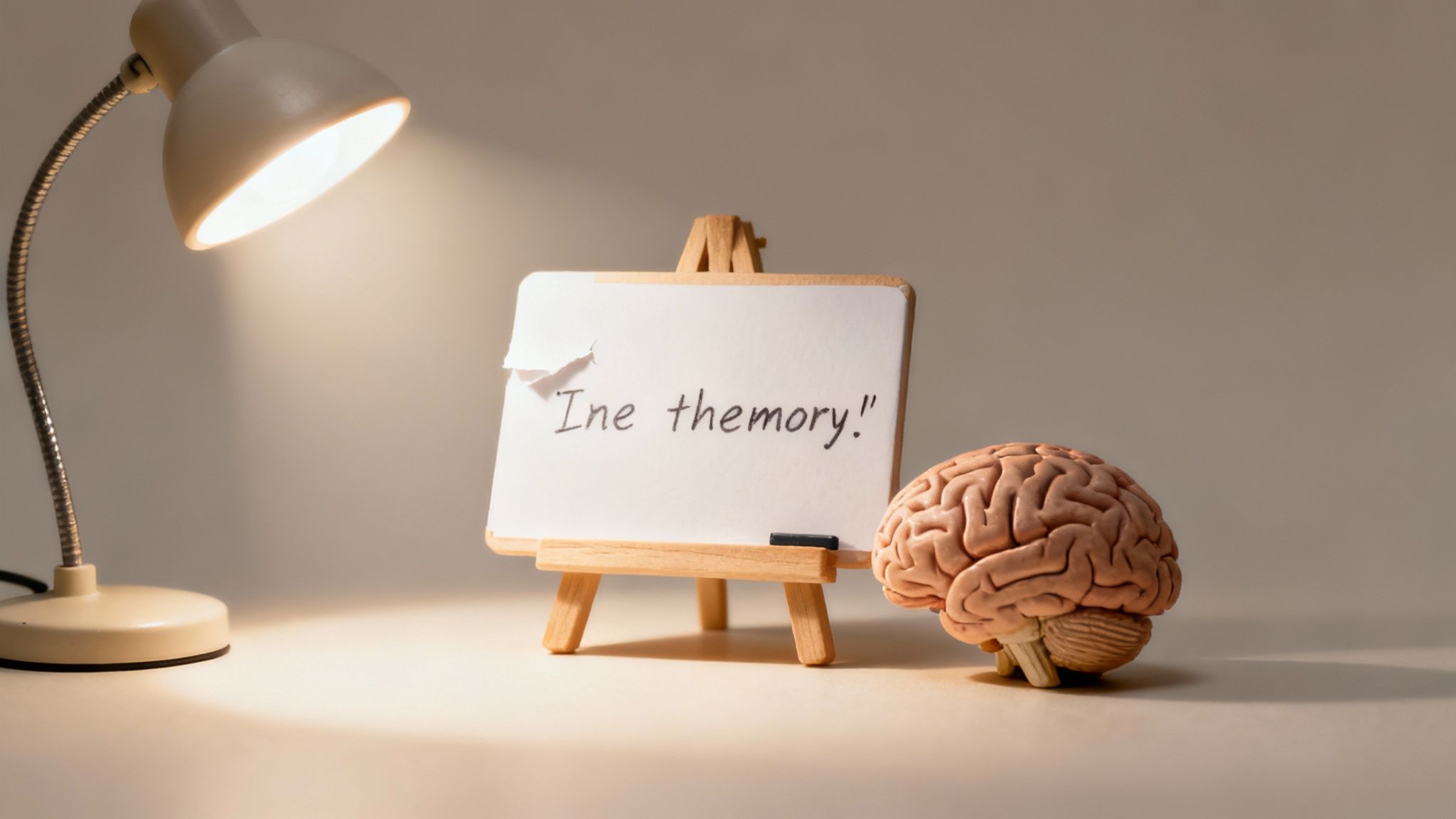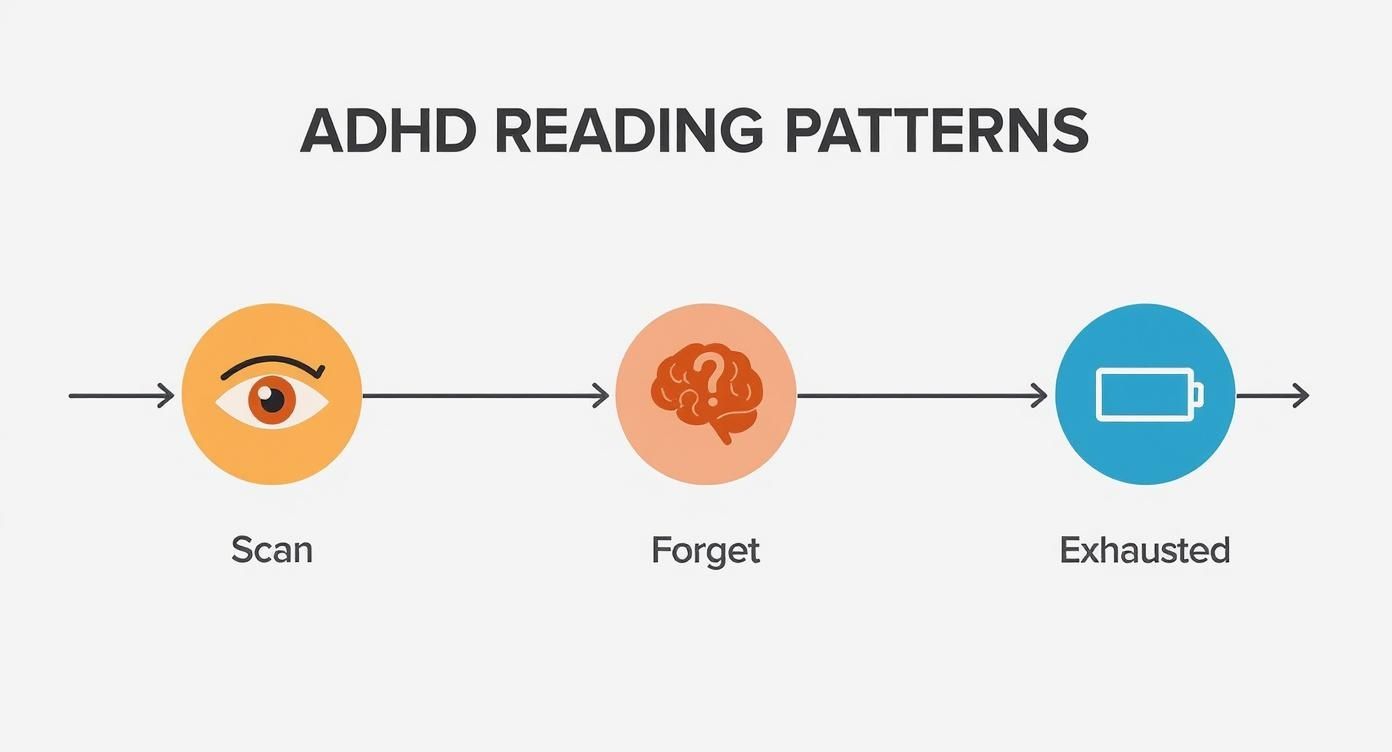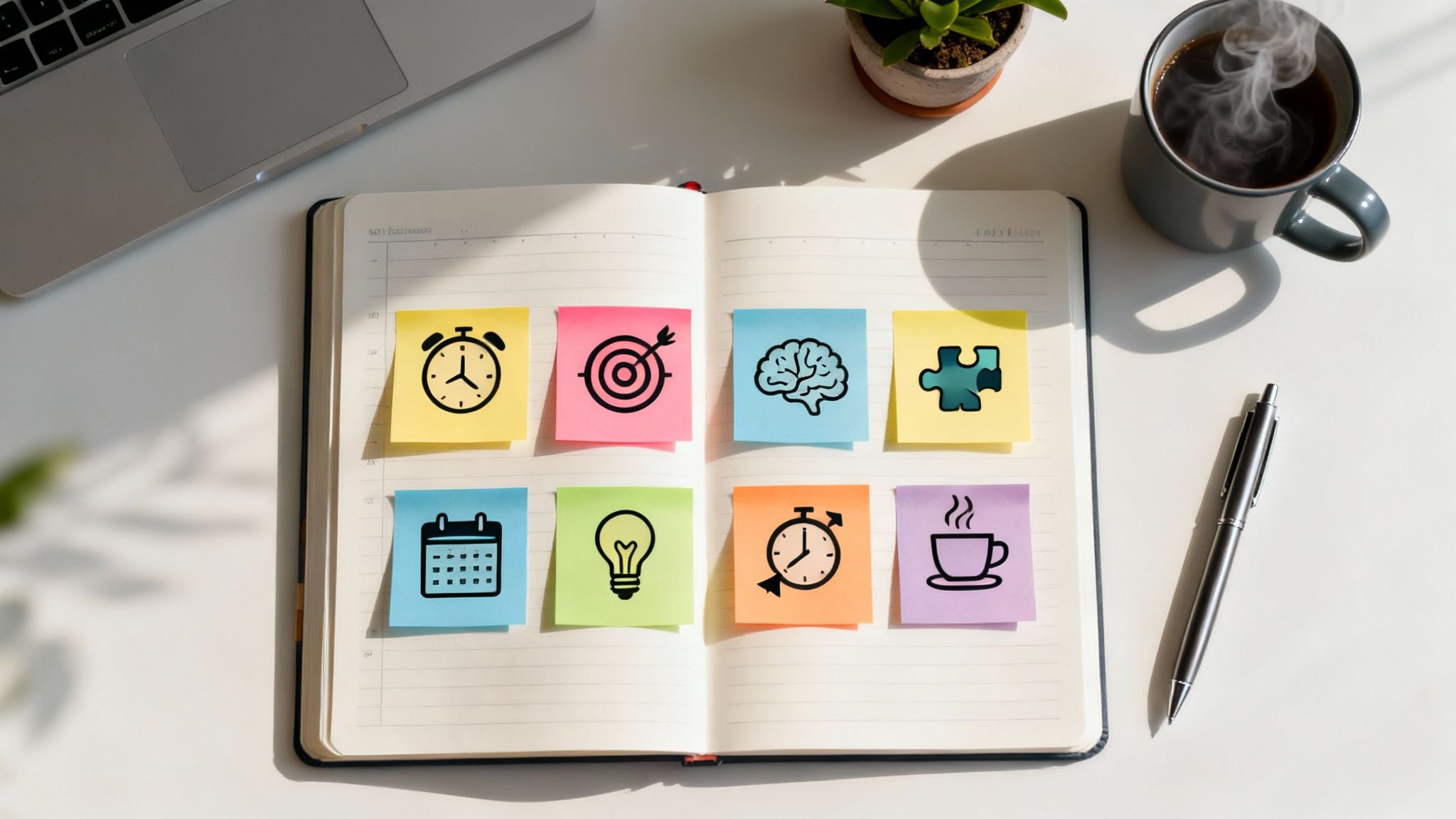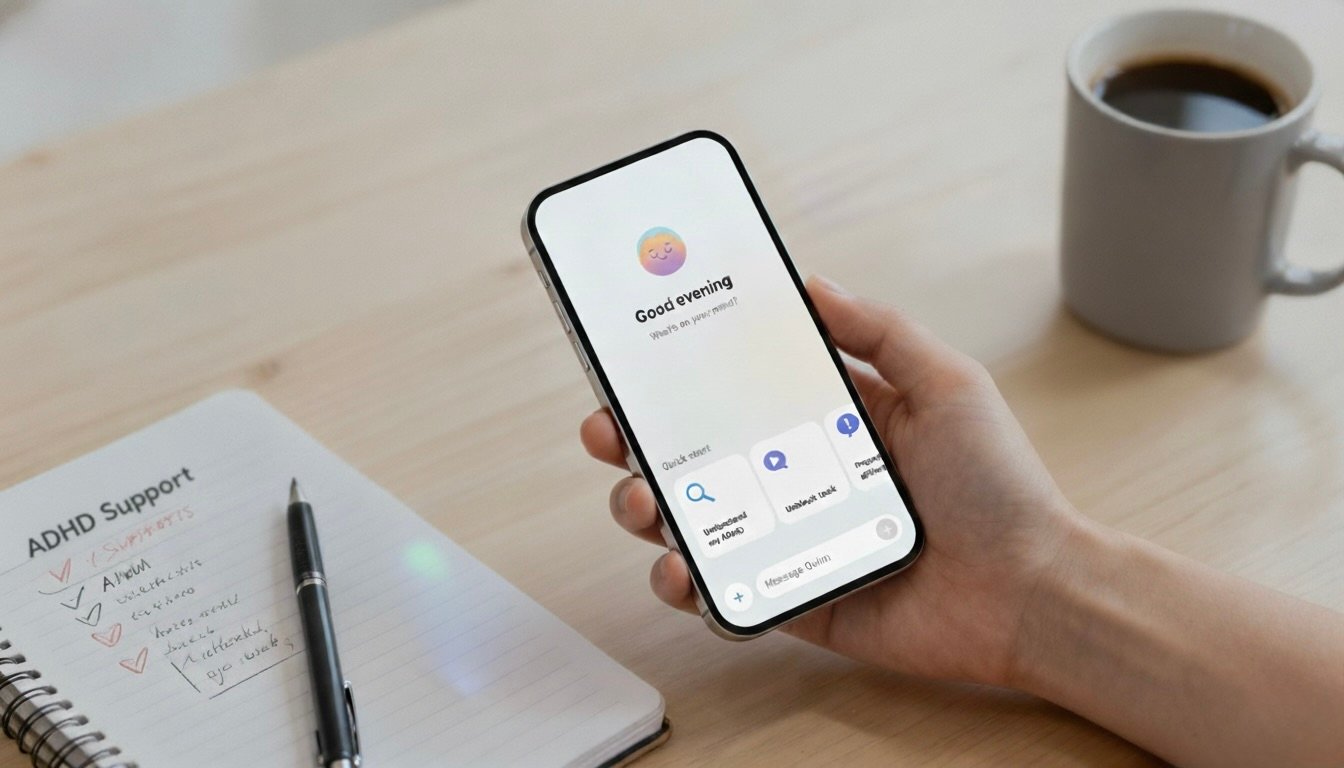Ever felt like you’re in a battle with the page you’re trying to read? Like your eyes scan the words, but your brain is somewhere else entirely? If you've ever reread the same paragraph three times only to realize you’ve absorbed nothing, you’re not alone. This isn't about a lack of intelligence or effort. It’s about how the unique wiring of an ADHD brain impacts the heavy lifting required for reading—skills like sustained attention and working memory that can make it tough to absorb and hold onto what you’ve just read.
This guide is here to help you feel seen, understood, and empowered. We'll explore why reading can feel so challenging with ADHD and offer practical, science-backed strategies that work with your brain, not against it.
Why Reading With ADHD Can Feel Impossible

Does this sound familiar? You sit down to read, determined to focus. But a few lines in, your mind is planning dinner, replaying a conversation, or wondering if you locked the car. It can feel like trying to listen to a single podcast while a dozen other browser tabs are blasting audio at the same time.
If you recognize yourself in this scenario, it's crucial to understand this isn't a personal failing. The core traits of ADHD directly interfere with the incredibly complex process of reading comprehension. Your brain isn't "bad" at reading; it just needs a different set of tools to get the job done.
The Real Culprits: Working Memory and Attention
Two key players in the ADHD brain are responsible for most of these reading challenges: working memory and sustained attention.
💡 Working Memory as a Brain's Notepad: Think of your working memory as your brain's temporary notepad. It’s where you jot down the beginning of a sentence so you can connect it to the end. In an ADHD brain, that notepad can feel frustratingly small and easily erasable. Information just seems to vanish before you get a chance to connect it to the bigger picture.
💡 Sustained Attention as a Flickering Spotlight: Sustained attention is your ability to keep a mental spotlight fixed on one thing. For an ADHD brain, that spotlight has a tendency to flicker or wander. When you’re reading, this means your focus can drift mid-sentence, leaving you with gaps in your understanding.
This internal battle isn’t just a feeling; it’s backed by science. Research consistently shows that children with ADHD face significant hurdles with reading comprehension, and these challenges often stick around into adulthood. In fact, studies show that somewhere between 25% to 40% of kids with ADHD also have reading difficulties.
🔬 Scientific Takeaway: A major reason for this is a deficit in executive functioning—the brain's management system. One study found that issues with executive function accounted for 61% of the difference in reading comprehension between kids with and without ADHD.
Understanding these underlying mechanics is genuinely empowering. It gives you a foundation to start building strategies that work with your brain. This process of self-understanding is a core part of what we do in the Inflow app—helping you spot these patterns in your own life and develop practical skills to manage them.
Have you noticed these patterns when you try to read?
Your Brain on Books: The Neuroscience of ADHD Reading

To really get why reading with ADHD can feel like such an uphill battle, it helps to look under the hood at what's happening in your brain. This isn't about willpower—it's about wiring. The challenges you run into are deeply rooted in how your brain processes information.
Thinking about the neuroscience of it all gives you a map to your own experiences, which is the first real step toward finding strategies that stick. You can explore more about the unique quirks and superpowers of the ADHD brain in our deep dive here. When you have this knowledge, you can stop fighting against your brain and start working with its natural flow.
The Working Memory Bottleneck
Picture your working memory as a tiny, very erasable whiteboard. As you read, you need this whiteboard to hold onto the beginning of a sentence while your eyes get to the end.
For the ADHD brain, that little whiteboard gets wiped clean fast. A new thought or a noise from outside can erase the crucial bit of info you just took in. This is why you might find yourself rereading the same sentence over and over—your brain is struggling to hang onto the data long enough to build meaning from it.
Executive Function: The Brain's Project Manager
If working memory is the whiteboard, then executive function is the project manager deciding what to write down and how to organize it. This set of mental skills helps you plan, prioritize, and make sense of information. While you're reading, your executive functions are working overtime to:
- Filter out unimportant details.
- Pinpoint the main idea.
- Link new information to things you already know.
- Organize plot points into a story that makes sense.
With ADHD, this project manager is often trying to juggle way too much at once. The result? You might feel lost in the text, unable to see the forest for the trees.
🔬 Scientific Takeaway: The issue isn't a failure to see details, but a struggle to prioritize and connect big ideas. A 2012 study on text comprehension discovered that while kids with ADHD could recall peripheral details, they had more trouble remembering the central ideas of a story compared to their non-ADHD peers.
Sustained Attention: A Wandering Spotlight
Finally, we have sustained attention. Think of it as a spotlight you need to keep pointed at the page. For someone with ADHD, it's constantly flickering and drifting off to illuminate something more exciting.
This isn't a choice. The ADHD brain is wired to hunt for novelty and dopamine, and a static page of text often doesn't offer a big enough reward to keep it hooked. One moment you're deep in a chapter, and the next, your spotlight has wandered off.
This shift in perspective is everything. It pulls you out of a place of self-blame and into a space of curiosity, where you can start asking, "Okay, so what does my brain need to make this work?"
Have you noticed how these three areas pop up in your own reading life? Recognizing these patterns is the first step toward building a more supportive approach with tools like Inflow.
Spotting the Usual Suspects: Common ADHD Reading Habits
If the last section hit close to home, this one might feel like looking in a mirror. So many of the reading struggles tied to ADHD are incredibly common, but they can feel like intensely personal failures. They’re not. They're just predictable patterns that show up when a brain built for novelty tries to tackle a linear, focused task like reading.
Figuring out your personal patterns is the first step toward finding strategies that actually work for you. It's about trading self-blame for self-awareness—a skill we spend a lot of time building in the Inflow app.
As you go through this list, see which ones make you say, “That’s me!”
The Mental Drift
✅ You read the words, but none of them sink in. Your eyes scan line after line, but your brain is already on a tangent. You hit the bottom of the page and realize you’ve absorbed precisely nothing.
This is that classic disconnect between your eyes and your brain. Your attention, that mental "spotlight" we talked about, has simply wandered off stage.
The Memory Fog
✅ You forget characters, plot points, and key ideas almost instantly. An hour after finishing a chapter, you can’t remember the main character's name. It’s like the information was written in disappearing ink.
This is your working memory getting overwhelmed. The information comes in, but it vanishes before it has a chance to connect to anything else.
The Overwhelm and Exhaustion
✅ Reading feels like a mental workout, and sometimes it just makes you sleepy. Slogging through a few pages can feel like running a marathon, leaving you cognitively fatigued.
This happens because your brain is working overtime to force itself to focus, filter out distractions, and patch a leaky working memory. That intense effort is genuinely exhausting. This can feel similar to the cognitive load people experience when navigating the combined challenges of ADHD and dyslexia.
The Detail Trap
✅ You get stuck on tiny details and completely miss the big picture. Ever find yourself rereading the same complicated sentence five times? While you’re zoomed in on that one little tree, you’ve totally lost sight of the forest.
This is an executive function challenge. Your brain’s "project manager" struggles to prioritize information, making it incredibly hard to build a coherent overview.
Each of these patterns is a signpost, not a flaw. They are simply the outward expression of the underlying neuroscience of ADHD. Does one of these stand out more than the others for you? Pinpointing your primary challenge is the key to choosing the right strategies.
Actionable Strategies to Improve Reading Comprehension
Knowing why reading is a challenge is empowering. Now, let’s get into the how. This isn't about forcing your brain to work like someone else's. It's about finding tools and brain hacks that actually work for your ADHD brain.
This infographic nails the frustrating loop so many of us get stuck in: scanning a page, immediately forgetting what it said, and feeling totally drained.

Sound familiar? That cycle of passive reading leads straight to mental exhaustion and zero retention. The strategies below are designed to break that cycle for good.
Phase 1: Before You Read
The point here is to create a mental roadmap before you start. Think of it as priming your brain—giving your wandering attention a clear structure to follow so it doesn’t get lost.
💡 Define Your Purpose: Ask yourself: Why am I reading this? Are you hunting for a specific answer? Trying to grasp a main concept? Just reading for fun? Knowing your "why" helps your brain filter what’s important.
💡 Skim and Scan: Don't just dive headfirst into a wall of text. Take two minutes. Look at the headings, subheadings, bolded words, and the first and last sentences of each paragraph. This gives you a quick mental outline.
Phase 2: While You Read
This is where the magic happens. The key is to turn reading from a passive, zoned-out activity into an active, engaging one.
💡 Use a Physical Guide: Seriously, this is a game-changer. Use your finger or a bookmark to trace the words as you read. This simple physical anchor gives your eyes a single point of focus, making it much harder for them to wander.
💡 Annotate Like a Pro: Grab a pen. Underline key sentences, circle new words, and scribble quick summaries or questions in the margins. This helps offload the heavy lifting from your working memory. Need more ideas? We've got more ADHD strategies to improve working memory.
💡 Use Timed Breaks: The Pomodoro Technique feels like it was made for ADHD brains. Read with focused intensity for 25 minutes, then take a mandatory 5-minute break. This gives your brain a chance to reset and prevents mental fog.
🔬 Scientific Takeaway: A clinical trial with students who had both ADHD and reading disabilities found that treating ADHD symptoms directly improved their reading comprehension more than reading-specific interventions alone. It shows that supporting your whole ADHD brain is just as important as learning new reading techniques.
Phase 3: After You Read
Don’t just close the book and walk away! What you do next is critical for locking in that information for the long term.
- Summarize in One Sentence: After a chapter or section, force yourself to boil down the main point into a single sentence. This makes your brain prioritize the most important takeaway.
- Explain It Out Loud: Try explaining what you just read to someone else—even your dog. The act of teaching forces you to organize your thoughts and reveals any gaps in your understanding.
- Use Technology to Your Advantage: When you're drowning in digital content, tech can be a lifesaver. For videos, YouTube summarizer tools can distill the key points, making dense information much easier to digest and remember.
Building these habits won't happen overnight, so be patient with yourself. The goal is progress, not perfection. The Inflow app helps you build this consistency with daily, bite-sized activities that turn these strategies into lifelong skills.
Designing Your Ideal Reading Environment

Your surroundings can either work with your ADHD brain or against it. Setting up an environment for success is one of the most powerful things you can do to improve ADHD reading comprehension. It's all about intentionally lowering the cognitive load from external distractions.
When your brain doesn't have to spend precious energy filtering out a messy desk or a noisy room, it has more resources left to focus on the text. The goal is to make reading feel less like a battle and more like a welcome escape.
Taming Your Sensory World
The ADHD brain can be incredibly sensitive to sensory input. A conversation in the next room or a flickering light can be just enough to yank your focus away. Managing these inputs is your first line of defense.
💡 Sound Control: A good pair of noise-canceling headphones can be a game-changer. You could also try ambient sounds like white noise or rain, which can help mask jarring noises that break your concentration.
💡 Visual Simplicity: Clear your space, both physical and digital. A cluttered desk creates visual noise that competes for your brain's attention. Close out all those extra tabs and silence notifications before you try reading on a device.
Choosing the Right Format for Your Brain
Not all reading formats are created equal, especially for a neurodivergent mind. The traditional book might not be the best fit for you, and that is completely fine. Don't be afraid to experiment.
- Audiobooks: These are fantastic. They let you bypass the mechanical challenge of tracking words on a page, freeing up cognitive resources to focus on meaning.
- E-Readers: Devices like a Kindle offer incredible flexibility. You can adjust the font size, style, and spacing until you find a layout that feels less overwhelming.
- Immersion Reading: This is a powerful combo of listening to an audiobook while you follow along in a physical or digital book. Engaging both your ears and your eyes can create a surprisingly strong anchor for your attention.
By finding the right format, you're not "cheating" at reading. You're simply choosing the tool that best fits the unique wiring of your brain.
Leveraging People and Timing
Your environment isn't just about physical space; it’s also about people and your own internal clock.
💡 Try Body Doubling: Ever notice it’s easier to focus when someone else is quietly working nearby? That's body doubling. The gentle accountability of having another person present can be incredibly grounding. Try reading in a library or a quiet coffee shop.
💡 Read With Your Energy Peaks: Pay attention to your natural energy cycles. Are you sharpest in the morning or after dinner? Try to schedule reading during these peak windows instead of forcing it when your brain is already running on fumes.
Building a supportive environment is a huge part of the holistic, CBT-informed approach we champion at Inflow. It’s about understanding your specific needs and creating systems that help you thrive. Which one of these environmental tweaks could you try today?
How Inflow Helps You Build Better Reading Habits
Knowing the right strategies is one thing, but using them consistently is where the real change happens. This is often the biggest hurdle for the ADHD brain, and it’s where a structured support system like Inflow can make all the difference in improving your ADHD reading comprehension.
Think of the Inflow app as an informed, empathetic friend in your pocket. It’s built on the principles of Cognitive Behavioral Therapy (CBT), which helps you understand the connection between your thoughts, feelings, and actions. This approach helps you see your unique reading patterns—not as personal failings, but as habits you can mindfully change.
From Strategy to Habit
It’s easy to feel motivated after reading a list of tips, but that feeling can fade. Inflow provides the gentle, daily structure you need to turn good intentions into skills that stick.
The app guides you through bite-sized daily modules and goal-setting features that help you build a reliable reading routine. It’s not just about learning what to do, but about creating a consistent practice. The goal isn't to force your brain to be "normal." It's to build a supportive scaffold around your natural cognitive style, making challenging tasks like reading feel more accessible and less draining.
Managing Frustration and Celebrating Wins
Let's be real: trying to build new reading habits can be frustrating. You’ll have days where your focus is on point and days where you can’t get through a single page. This is a normal part of the process, and Inflow is designed to help you navigate those ups and downs.
The program teaches you to manage the emotional side of ADHD, including the frustration and self-criticism that can flare up when you struggle. It helps you reframe setbacks as learning opportunities.
Most importantly, Inflow encourages you to notice and celebrate your progress. Did you read for 10 minutes without getting distracted? That’s a win. These small celebrations build momentum and reinforce the new habits you’re working so hard to create. If you want a closer look at how it all works, you can learn more about the Inflow ADHD management app.
Inflow isn’t just about managing symptoms—it's about building a life where activities like reading can finally become enjoyable and rewarding.
Got Questions? We've Got Answers
Let's dig into some of the most common questions about ADHD and reading.
Can ADHD Medication Help With Reading Comprehension?
For many people, yes. Stimulant medication can be a game-changer for the core ADHD symptoms that get in the way of reading. By helping with focus and attention, meds can create the mental space for reading strategies to actually work.
However, medication isn't a magic wand for reading skills. It's one tool in a bigger toolbox. The sweet spot is often a combination: medication to help manage ADHD symptoms, paired with consistent practice of the right reading techniques.
Are Audiobooks a Good Idea for ADHD Brains?
Absolutely. Audiobooks are fantastic because they let you bypass the mechanical part of reading—the eye-tracking and staying on the right line—that can be a real battle. This frees up mental energy, letting you focus on the story or the big ideas.
💡 Pro-tip: Try "immersion reading." This is where you listen to the audiobook while following along in the physical book. By engaging both your ears and your eyes, you create a powerful anchor for your focus. Many people find this dual-sensory approach seriously boosts how much they take in and remember.
Why Does Reading Make Me So Sleepy?
If this happens to you, you're not alone. It's an incredibly common experience for people with ADHD, and it’s rarely about being physically tired. More often, it’s a classic case of understimulation. Reading can feel passive, and a dopamine-seeking ADHD brain might just try to "check out" by getting drowsy.
It can also be a sign of pure cognitive exhaustion. The mental effort it takes to force focus, juggle information in a taxed working memory, and block out distractions is genuinely draining. Trying more active reading strategies—like jotting down notes or reading parts aloud—can make a world of difference.
Understanding these patterns is the first step to building a better relationship with reading. By using tools and strategies that work with your brain's unique wiring, you can turn reading from a chore into something you can enjoy.







